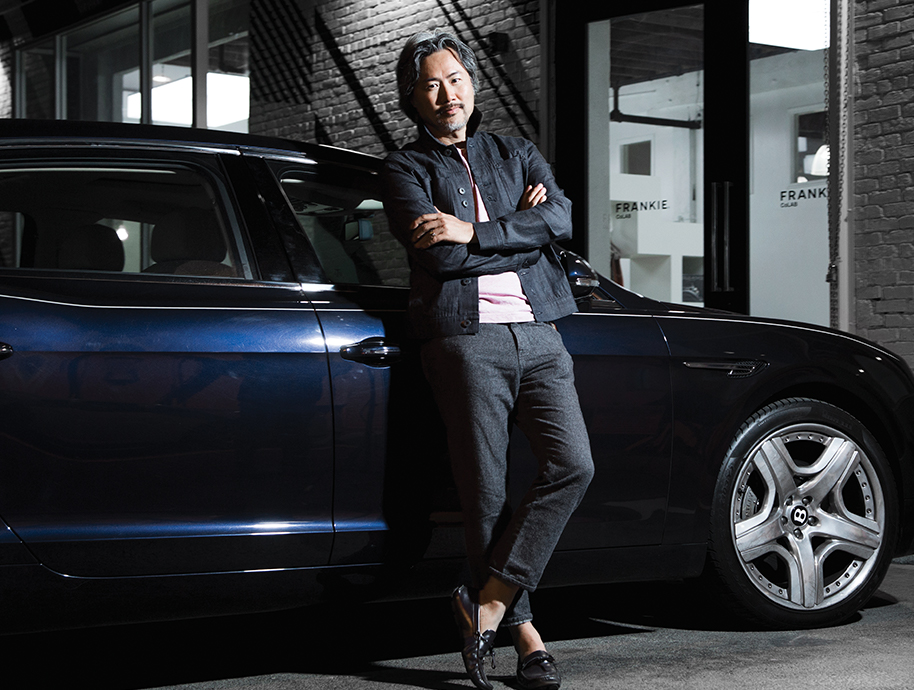Kevin Chen is no ordinary fashion trendsetter. An accomplished Asian American fashion and real estate entrepreneur, in the last few years he has been at the epicenter of LA’s style resurgence and has made bicoastal real estate acquisitions in the United States two largest markets: LA and New York. Chen relaunched the fashion brand FRANKIE in 2016 to much acclaim, and has been a key player in the revival of the DTLA Arts District in Los Angeles. Now, with an ambitious plan to expand internationally and open more than 100 locations in China and across the globe, we caught up with him to find out what’s happening with China’s luxury fashion consumers, the global real estate market, and what we can expect from FRANKIE in 2018.
Q: As an Asian entrepreneur, what makes LA and the Pacific Rim Region attractive for business?
KC: Los Angeles is the United States leading gateway to the Pacific Rim Region; it consists of the most trans-Pacific flights and ocean-based shipments. Most of these countries included – from the North and South Americas to Asia to Oceania – have experienced major economic change and growth, transforming into economically integrated trade centers.
China is attempting to foray into the Pacific Rim with Special Economic Zones and Open Coastal cities – like Hong Kong and Shanghai – which have special incentives for international investors. Los Angeles is also China’s top international trade gateway to the U.S., handling nearly 45% of trade between the two countries. The Pacific Rim continues to gain strength in the global economy, and the value of United States imports from Pacific Rim countries has become greater than those from the NATO (North Atlantic Treaty Organization) members in Europe.
Q: You’ve built FRANKIE into an LA brand, and now appear to be taking it international. Talk to us about that process and the opportunities you see in the booming Asian and international markets?
KC: The legacy of the brand from its roots was what initially grabbed my attention. FRANKIE B was notorious for introducing a signature trend to the premium denim market: low-slung jeans. With a 6” rise, the garments were under spotlight. In 1999, the brand was launched in Los Angeles by Daniella Clarke (wife of musician and former Guns N’ Roses rhythm guitarist, Gilby Clarke), and soon after, everyone was after the super low-rise jeans.
FRANKIE B started a revolution. It was the most converted denim trend in the early 2000’s, and it instantly gained a strong celebrity following. Kate Moss, Jennifer Lopez, Fergie, Christina Aguilera, Miley Cyrus, Selena Gomez, Jessica Alba, Katie Holmes, Eva Longoria, Charlize Theron and Megan Fox to name a few.
When my team and I relaunched the brand as FRANKIE in 2016, Los Angeles was quickly on its way to international recognition – becoming the most creative and desirable place to be. With its revolutionary rock n’ roll roots, the vision is to continue and expand that legacy into a ready-to-wear brand in the place it was born. Our new collection of premium denim, leather jackets, and contemporary garments preserves the brand’s original rock chic and Hollywood glamour for the modern and culturally-diverse women in Los Angeles taking over the streets today. We develop all of our pieces in small atelier factories in Los Angeles and New York, sourcing high-quality fabrics from the best manufacturers from France, Italy, Japan and America.
I’m also excited to mention that FRANKIE has achieved another milestone last September: its first flagship store in the Arts District of Downtown Los Angeles, already recognized as The Best Boutique Interior of 2016 by Azure Magazine. With the brand, I’ve also been nominated as a Fashion Trendsetter Award Finalist of 2016 by Los Angeles Business Journal.
This September, we’ve brought FRANKIE to New York and opened a pop-up store in Nolita/Soho. The FRANKIE NY flagship is projected to open in Spring 2019 in Chelsea, Hudson Yards New York.
Second, the opportunities in the booming Asian and international markets.
In terms of international expansion, China is our top choice. The economy is beginning a historic shift to a more consumption and service-driven model that will benefit and sustain the country’s growth over the next decade and beyond. Beijing is ambitious in the next chapter of China’s growth. Consumption is expected to overtake investment as the largest contributor to China’s GDP growth. In the luxury goods segment, 75% of all sales will be from Chinese consumers, with more than half of that being spent outside of the nation.
Two pressing drives of global brand expansion are internet sales and global travel. Asia is quickly coming into its own, opening doors to so many new business and tourism opportunities. Another drive: the millennials. A joint study by the Singapore Tourism Board (STB), Visa, and McKinsey & Company revealed that approximately 60% of the world’s millennials reside in Asia. Even before entering the prime of their earning power, millennials already account for almost 35% of the US$600 billion spent on international travel. Driven by income growth, the millennials in Asia’s expenditure on international travel is expected to increase by 1.6 times to US$340 billion by 2020.
Latin America is also one of the fastest growing markets globally. Stronger underlying economic activity and cooling inflation are set to boost disposable income and spending in this region of 650 million people. This will open up expansion opportunities for multinational fashion brands. In Europe, the United Kingdom and Germany have the largest apparel and clothing market within the continent.
All of these challenges come with great opportunities. Global brands give companies competitive advantages, such as: economies of scale in production and distribution, lower marketing costs, power and scope, consistency in brand image, ability to leverage ideas quickly and efficiently, and uniformity of marketing practices. The rise of global culture doesn’t mean that consumers share all the same tastes or values, but global brands do allow people to connect in an open and mutual conversation drawn on shared symbols.
Q: There’s this concept of building an American brand and then selling into Asia. What does the high-end Asian consumer look for in the fashion and brands they wear?
KC: In the past, luxury goods and premium brands were seen as a symbol of wealth and status for most the consumers. Now, we see buyers shift away from visibly branded goods to a focus on the quality of their garments.
Today, the high-end Asian consumer are looking to buy goods for their own enjoyment. They are more confident, and they have much more of an understanding of lifestyle. The younger and more sophisticated generation of shoppers with markedly different tastes, aspirations and consumption habits is reshaping the landscape of fashion trends in Asia, especially in China. Educated, well-traveled and tech-savvy, they are emerging as the new target market. 39 percent of wealthy Chinese think the logo is no longer the priority. In America, we build a brand that conveys the unique sociocultural and individual meanings to their adherents. Brands that harness word-of-mouth effects, emphasize in-store execution, and digital platforms get the brands onto shoppers’ short lists for initial consideration are more likely to capture the loyalty of emerging-market consumers.
Niche high-end collections are becoming new drivers of luxury consumption. Customers, especially women, between the ages of 25 and 35, are interested in ready-to-wear brands. It is the fastest-growing segment in mainland China. Chinese shoppers account for nearly half of the global luxury market, providing invaluable demand to brands in every segment.
There’s a real thirst for newness. It’s not just about purchasing, it’s about the experience.
Q: What synergy do you see between the US and Chinese fashion industries; and more generally, between the two business communities?
KC: The global manufacturing map is changing fast, raising questions about the future of China’s status as ‘the world’s factory.’ More and more Chinese firms are investing in technological innovation, specialization and quality upgrades, contributing to the development of the country’s advanced manufacturing sector. The explosive growth of high quality, locally made fashion will help China’s manufacturing sector remain globally competitive.
Q: Now in LA and New York; where will FRANKIE be expanding to next?
KC: FRANKIE’s next expansion market will be China. We plan to partner with Chinese companies to establish e-commerce and retail. FRANKIE will have flagship locations in Beijing and Shanghai in 2018, followed with 100 stores rolling out in the next four years.
FRANKIE will also work with local distributors including the countries within the Pacific Rim Region. In Europe, we’re focused on wholesale key retailers in England, Germany, France and Italy. We’re also looking to work with distribution in the Middle East and South American regions.
Q: You also invest in real estate, and made a significant property acquisition in the booming DTLA Arts District. As an investor, what US markets do you see opportunity in, and what trends and behaviors are you seeing from overseas Asian investors?
KC: Absolutely. In 2007, China’s commercial property outflow global investment was less than $1 billion. Now it exceeds $20 billion annually.
Mainland Chinese buyers’ fascination with American property continues unabated, with each family spending an average of US$529,943 per property, according to a report from the US National Association of Realtors. Based on sales reported by member agents, home buyers from China acquired 40,572 residential units in the United States in the 12 months to March 31, 2017 up from 29,195 units in the previous 12 months. This equated to US$31.7 billion in sales, up 16.1% year-on-year. Chinese buyers remain the biggest foreign investor group, accounting for 14% of all sales to international buyers, and 26.6% of the total spend.
According to the data, the four biggest markets they’ve bought in are California (37%), Texas (11%), Florida (8%), and Illinois (7%). New York accounted for only 4%. The majority were acquiring properties for self use, in suburban locations, detached houses and “paying all cash”.
Chinese investors are drawn to these cities because of quality educational institutions and opportunities, and according to the report, “children’s education” was the top reason driving demand, just ahead of migration. Five US housing markets where Chinese buyers are projected to spend the most money in the next 12 months: Los Angeles, California; Miami, Florida; New York, New York; San Francisco, California and Boston, Massachusetts.
Although expecting that the volume of purchases could abate slightly in 2017, USNAR foresees sustained buyer demand over the coming years “as Chinese individuals and businesses continue to become an integral part of the global community”.
YOU MAY ALSO LIKE







